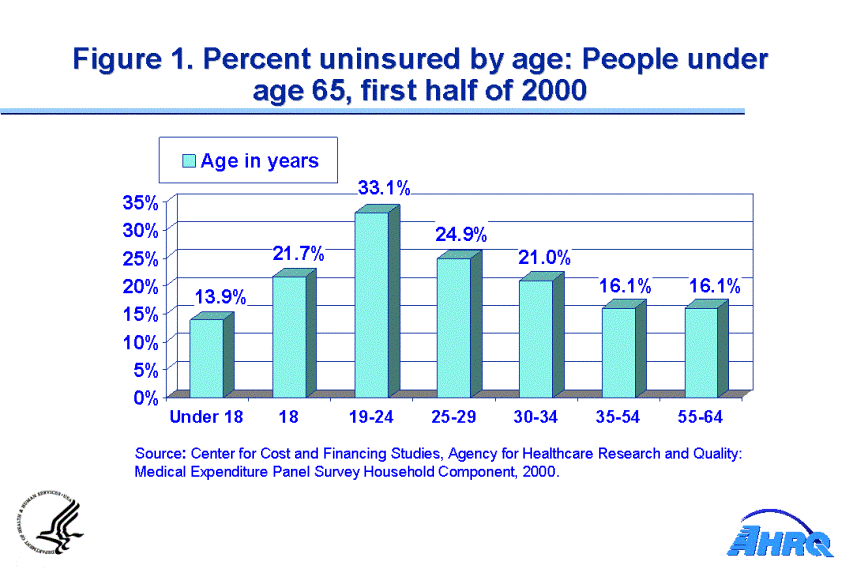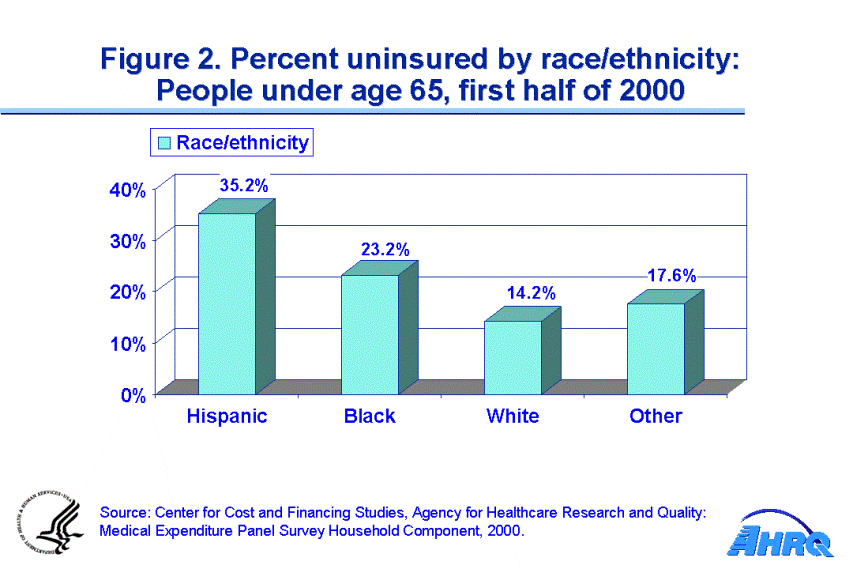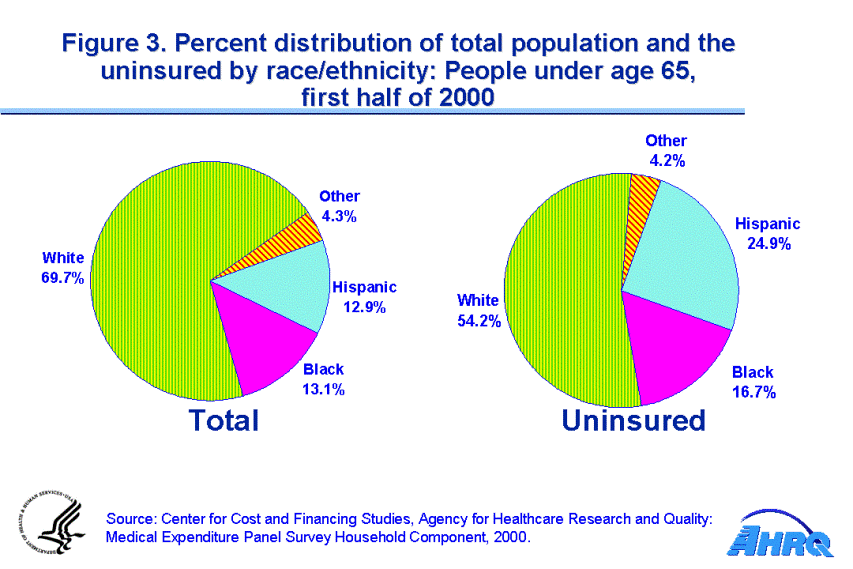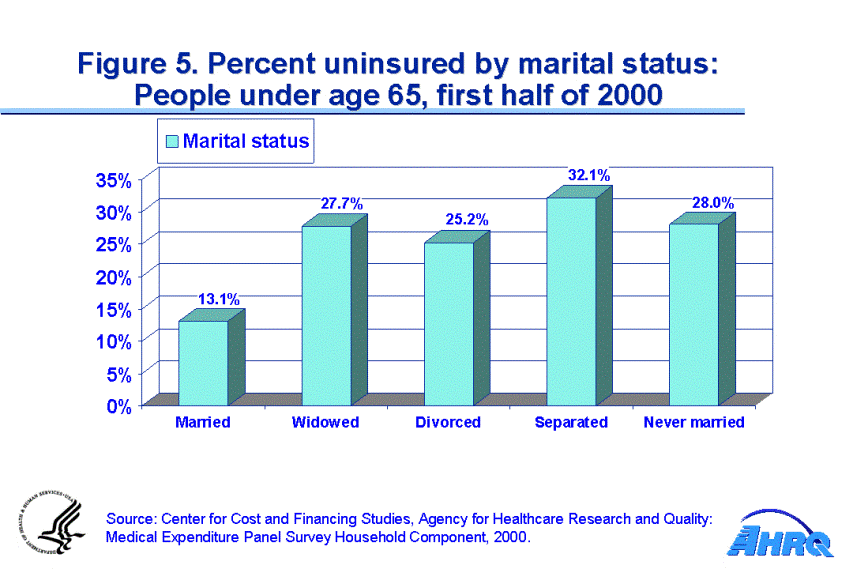
|
|
Font Size:
|
||||
|
|
|
|
||||
STATISTICAL BRIEF #1:
The Uninsured in America - 2000: Estimates for the Civilian Noninstitutionalized Population Under Age 65
Briefly Stated
- In the first half of 2000, 16.1 percent of the U.S. civilian noninstitutionalized population were uninsured.
- Among the U.S. civilian noninstitutionalized population under 65, more than a third of Hispanics (35.2 percent) and 23.2 percent of black non-Hispanics were uninsured during the first half of 2000, compared with only 14.2 percent of white non-Hispanics.
- Among people under 65, Hispanics accounted for one-fourth (24.9 percent) of the uninsured civilian noninstitutionalized population even though they represented only 12.9 percent of the overall population this age.
- Young adults ages 19-24 were the age group at the greatest risk of being uninsured, one-third (33.1 percent) of this group lacking health insurance.
Introduction
The uninsured population in the United States is an issue of public policy concern for several reasons. First, health insurance is viewed as necessary to ensure that people have access to medical care and protection against the risk of costly and unforeseen medical events. Timely and reliable estimates of the population's health insurance status are vital to evaluate the costs and expected impact of public policy interventions to expand coverage or to change the way that private and public insurance is funded. Finally, comparisons of the characteristics of insured and uninsured populations over time give information on whether greater equity has been achieved in insurance coverage or whether serious gaps remain.
Data from the 2000 Medical Expenditure Panel Survey (MEPS) of the Agency for Healthcare Research and Quality (AHRQ) show that health insurance status among people under 65 varies according to demographic characteristics such as age, race/ethnicity, sex, and marital status. This report shows the size of the civilian noninstitutionalized population under age 65 that was uninsured throughout the first half of 2000 and identifies groups especially at risk of lacking health insurance. MEPS population estimates for 2000 are not significantly different from 1999 MEPS estimates reported in Rhoades and Chu, 2001.
Definition of Uninsured
The uninsured were defined as people not covered by Medicare, TRICARE (Armed-Forces-related coverage), Medicaid, other public hospital/physician programs, or private hospital/physician insurance (including Medigap coverage) from January 2000 through the MEPS interview date. People covered only by noncomprehensive State-specific programs (e.g., Maryland Kidney Disease Program) or private single-service plans (e.g., coverage for dental or vision care only, coverage for accidents or specific diseases) were not considered to be insured.
Findings
In early 2000, 16.1 percent of the U.S. civilian noninstitutionalized population (44.0 million) were uninsured and 18.2 percent (43.8 million) of these Americans under the age of 65 were uninsured (data not shown). Age plays a key role in whether a person has health insurance coverage. Young adults ages 19-24, 33.1 percent of whom were uninsured, were the age group at the greatest risk of being uninsured (Figure 1). This group composed 9.5 percent of the total non-elderly population but 17.2 percent of the uninsured population (data not shown).
Among people under age 65, minorities were substantially more likely than whites to lack health insurance. For all Hispanics under 65, 35.2 percent were uninsured, compared to 23.2 percent of black non-Hispanics and 14.2 percent of white non-Hispanics (Figure 2). Although 69.7 percent of non-elderly Americans were white non-Hispanics, they accounted for only 54.2 percent of uninsured persons (Figure 3). Among males under age 65 (Figure 4), being uninsured was more likely among Hispanics (37.6 percent) than among black non-Hispanics (24.9 percent) or white non-Hispanics (15.5 percent). Similarly, among females under 65, being uninsured was more likely among Hispanics (32.8 percent) than among black non-Hispanics (21.6 percent) or white non-Hispanics (12.9 percent).
Persons who never married accounted for nearly a quarter (23.7 percent) of the non-elderly population but over a third (36.5 percent) of the uninsured population (data not shown). Also, about a third (32.1 percent) of all persons under 65 who were separated were uninsured (Figure 5).
About MEPS
The Medical Expenditure Panel Survey (MEPS) collects nationally representative data on health care use, expenditures, sources of payment, and insurance coverage for the U.S. civilian noninstitutionalized population. MEPS is cosponsored by the Agency for Healthcare Research and Quality (AHRQ) and the National Center for Health Statistics (NCHS). This Statistical Brief summarizes data concerning the characteristics of the uninsured population in the United States during the first half of 2000, as derived from the MEPS Household Component. For more information about MEPS, see the sources listed on the last page.
 |
||||||||||||||||||||||||||||||||
|
||||||||||||||||||||||||||||||||
|
|
||||||||||||||||||||||||||||||||
 |
||||||||||||||||||||||||||||||||
|
||||||||||||||||||||||||||||||||
|
|
||||||||||||||||||||||||||||||||
 |
||||||||||||||||||||||||||||||||
|
||||||||||||||||||||||||||||||||
|
|
||||||||||||||||||||||||||||||||
 |
||||||||||||||||||||||||||||||||
|
||||||||||||||||||||||||||||||||
|
|
||||||||||||||||||||||||||||||||
 |
||||||||||||||||||||||||||||||||
|
||||||||||||||||||||||||||||||||
For more information about MEPS, call the MEPS information coordinator at AHRQ (301-594-1406) or visit the MEPS Web site at: http://www.meps.ahrq.gov/ For a detailed description of the MEPS survey design, sample design, and methods used to reduce sources of nonsampling error, see the following publications: Cohen J. Design and Methods of the Medical Expenditure Panel Survey Household Component. Rockville (MD): Agency for Health Care Policy and Research; 1997. MEPS Methodology Report No. 1. AHCPR Pub. No. 970026. Cohen S. Sample design of the 1996 Medical Expenditure Panel Survey Household Component. Rockville (MD): Agency for Health Care Policy and Research; 1997. MEPS Methodology Report No. 2 AHCPR Pub. No. 970027. |
||||||||||||||||||||||||||||||||
|
|
||||||||||||||||||||||||||||||||


